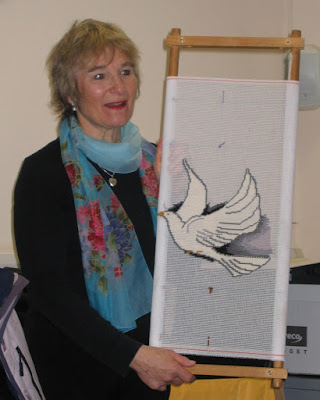(I’m aware that for a sewing blog, there’s been very little actual sewing posted on here recently. Unusually for me, I’ve fallen off the dressmaking wagon a bit - March isn’t a good time in my world. But it’s April now, and normal service will be resumed soon. In the meantime . . . )
I recently bought a bundle of vintage patterns online. They were described as mostly 1940s and 1950s, and so it proved, but nestling in among them was this.
 |
| The pattern as it first appeared |
I’d heard of Victorian patterns being printed on a single sheet, with all the pieces overlaid, and I’d see reproductions in books, but I’d never before held one in my hot (and slightly shaking) little hand.
At first glance, it didn't look too complicated. But then I unfolded it a bit further.
 |
| Starting to look more complex |
Initially I thought that it was some sort of reproduction pattern. Then I turned it over.
 |
| April 1874! |
To say that I was amazed is a serious understatement! I've not been able to find out much about the
Journal des Dames et des Demoiselles, as all the articles online seem to be in French (well, duh). I did find this bound copy of the 1871 editions, being sold by bookseller Antikvariát Valentinská.
The Journal does seem to have included some colour prints, although this may have been a cover illustration.
I'm guessing that the pattern was given away with the magazine. It is printed on both sides, on very thin paper.
 |
| Side one |
 |
| Side two |
Each side contains pattern pieces for three different items, and also gives a brief description.
 |
| Side one illustrations - the printing on the other side shows through the thin paper |
 |
| Side two illustrations |
 |
| Side one description |
So far I've only looked at side one in detail. The patterns are only for the jackets, not the full outfit. The third item is described as a 'parure'; totally confusing as I've always thought that a parure is a
set of jewellery.
At first glance, the pattern looks like an impossibly complicated jumble of lines. When you look more closely however, each piece uses a different, distinctive, line style.
 |
| Different line styles |
It is actually quite straightforward to trace each piece off onto tissue paper. I've done this for the first item, the 'Casaque de printemps' (literally, 'spring blouse').
 |
| Bodice pieces |
 |
| Sleeve pieces |
The sleeve looks quite straightforward, but I'm mystified as to how the bodice pieces fit together. I'm hoping that the brief 'explications' will provide some clues if I translate them. I studied French until I was 17, but nineteenth century dressmaking terms didn't feature much in the lessons. Fortunately a friend has a French degree, and is going to lend me her student dictionary. She was worried that I might find it a bit old-fashioned; I've assured her that for what I need, this won't be a problem!













































